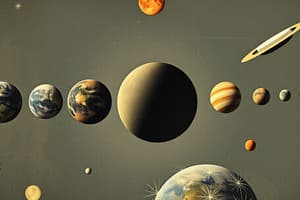Podcast
Questions and Answers
What describes the process by which rocks are formed, broken down, and transformed over time?
What describes the process by which rocks are formed, broken down, and transformed over time?
- The Rock Cycle (correct)
- Sedimentary Formation
- Energy Transfer
- Matter Transfer
Which type of igneous rock has a silica content greater than 65%?
Which type of igneous rock has a silica content greater than 65%?
- Felsic (correct)
- Mafic
- Ultramafic
- Intermediate
What is the primary gas composition of Mars based on the information provided?
What is the primary gas composition of Mars based on the information provided?
- 95% Nitrogen, 2.7% CO2
- 95% CO2, 2.7% Nitrogen (correct)
- 0.13% Oxygen, 95% Argon
- 98% CO2, 1.6% Argon
Which statement best describes intermediate igneous rocks?
Which statement best describes intermediate igneous rocks?
What process entails the gathering of sediments to form sedimentary rocks?
What process entails the gathering of sediments to form sedimentary rocks?
What type of planets are Mercury, Venus, Earth, and Mars classified as?
What type of planets are Mercury, Venus, Earth, and Mars classified as?
How thick is Earth's atmosphere approximately?
How thick is Earth's atmosphere approximately?
Which of the following factors is NOT one of the five that make Earth habitable?
Which of the following factors is NOT one of the five that make Earth habitable?
What percentage of Earth's surface is covered by liquid or frozen water?
What percentage of Earth's surface is covered by liquid or frozen water?
Which characteristic is typical of Jovian or outer planets?
Which characteristic is typical of Jovian or outer planets?
What role do nutrients play in an organism's body?
What role do nutrients play in an organism's body?
What type of energy is essential for running the chemical reactions necessary for life?
What type of energy is essential for running the chemical reactions necessary for life?
Which planet is confirmed to host life?
Which planet is confirmed to host life?
Study Notes
Earth Overview
- Earth is known as the "living planet" and the "blue planet."
- Third planet from the sun; uniquely hosts and supports life.
- Surrounded by four critical factors: temperature, atmosphere, energy, and nutrients.
Planetary Division
-
Terrestrial/Inner Planets: Mercury, Venus, Earth, Mars.
- Smaller size and mass; rocky surfaces.
- Warmer due to proximity to the sun.
-
Jovian/Outer Planets: Jupiter, Saturn, Uranus, Neptune.
- Larger size, mostly gaseous composition (helium and hydrogen).
- Cooler temperatures; referred to as "Gas Giants."
-
Pluto: Classified as a dwarf planet; exists in the Kuiper belt.
Key Facts about Earth
- Atmosphere: About 100 miles thick; warms surface and protects against radiation.
- Water: Earth uniquely possesses a significant amount of liquid water; approximately 70% of the surface is water-covered.
- Five Factors Making Earth Habitable:
- Temperature
- Water
- Energy
- Atmosphere
- Nutrients
Composition and Atmosphere of Neighboring Planets
- Venus: Highest temperatures due to 98% CO2 concentration.
- Mars: Atmosphere composed of 95% CO2, with small amounts of nitrogen, argon, and oxygen.
Earth’s Subsystems
- Hydrosphere: All water components.
- Atmosphere: Gaseous layer surrounding Earth.
- Lithosphere: Earth's solid surface.
- Biosphere: Regions hosting life.
Interconnections and Processes
- Matter Transfer: Interconnections among Earth system components.
- Energy Transfer: Central process driving Earth’s systems.
- Change Leads to Change: Interconnected changes across the Earth's spheres.
Rock Cycle
- Describes processes of rock formation, breakdown, and transformation.
- Sedimentary Rocks: Formed by compaction and cementation of sediments.
Igneous Rocks Classification
-
Felsic:
- High in silica (>65%); light-colored (e.g., granite, rhyolite).
-
Intermediate:
- Moderate silica content (55-65%); medium gray (e.g., andesite, diorite).
-
Mafic:
- Lower silica content (45-55%); dark-colored.
-
Ultramafic:
- Very low silica content; contains high magnesium and iron.
Studying That Suits You
Use AI to generate personalized quizzes and flashcards to suit your learning preferences.
Description
Explore the fascinating characteristics of Earth, the 'living planet,' and learn about its division into terrestrial and jovian planets. This quiz covers essential facts about Earth's atmosphere, water resources, and fundamental factors that sustain life. Test your knowledge about our unique planet and its place in the solar system.




